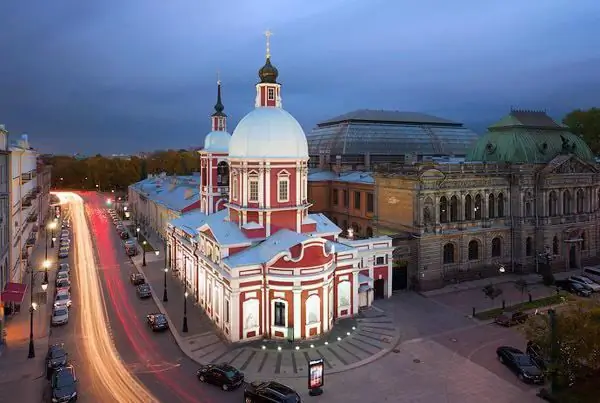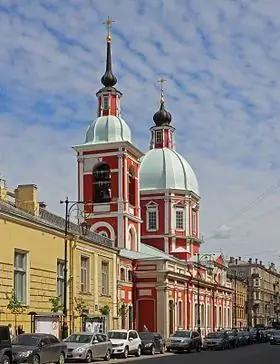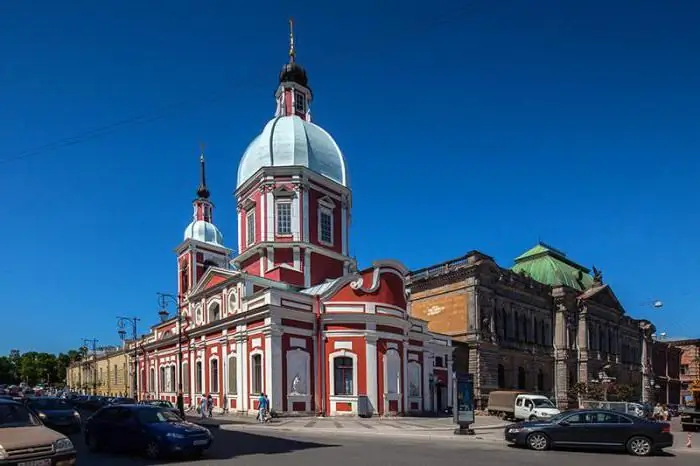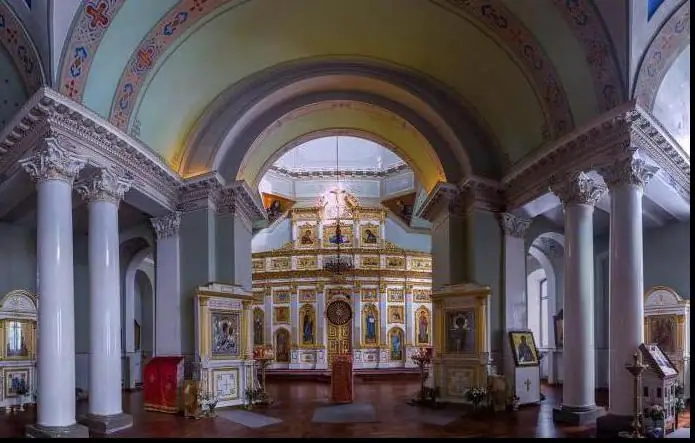- Author Miguel Ramacey [email protected].
- Public 2023-12-17 06:11.
- Last modified 2025-01-24 21:21.
The Panteleimon Church is one of the oldest in St. Petersburg. It was founded under Peter the Great. The temple is an excellent example of the Russian Baroque style. But this is not the only reason why it is worth visiting the Orthodox Church of the Holy Great Martyr and Healer Pantelemon (this is the full official name of the church). It is also a monument to the naval victories of the Russian flotilla. The church has an interesting history that all connoisseurs of the architecture of St. Petersburg should definitely know. In this essay, we will talk about how the Panteleimon temple was built, about its appearance and interior decoration.

How to get to this attraction
This church can be visited while visiting other monuments of the city. After all, it is located in the Central region. The address of the temple is very simple: st. Pestelya, 2A, St. Petersburg. Panteleimon's Church is located on the corner of this street, where it intersects with S alt Lane. You can get to the temple from three metro stations: "Gostiny Dvor" (fifteen minutes walk fromsubways), "Chernyshevskaya" (1.4 km) and "Nevsky Prospekt" (a little more than one and a half kilometers). The church gave its name to the Panteleymonovsky bridge across the Fontanka River. As well as the street on which the temple is located (the name of Pestel was assigned to it in 1925). If you came to St. Petersburg for a short time and would like to see all the sights of the central part of the city on the Neva in one day, then you can get to the Panteleimon Church from the Admir alty and the Summer Garden, from another beautiful Church of the Savior on Spilled Blood and from Mikhailovsky Castle. Walking along the Fontanka embankment, you will come to Pestel street.

Prehistory of the Panteleimon Church
During the time of Peter the Great, this place, near the mouth of the Fontanka, was the Particular Shipyard. There, workers built and repaired ships for the navy. And on July 27, 1714, Russian sailors won a naval battle with the Swedes near Gangut (the modern name of Hanko). After this victory, Peter the Great ordered to build a small chapel for the shipyard workers. After all, they, albeit indirectly, were also involved in the victory of the Russian fleet. The chapel was small, wooden. It was consecrated in honor of the healer and great martyr Panteleimon, since the victory at Gangut was won on the day when the Orthodox Church honors the memory of this saint. The second event - the Battle of Grengam Island in 1720 - raised the status of the chapel. After all, a new victory was won exactly on the same day as the first - July 27. Therefore, Tsar Peter sent a dispatch with an order to build a church on the site of the chapel, which would at the same timeand a monument to the glory of the Russian fleet. The architect Nikolai Gerbel built the temple in two years. Panteleimon's church was originally a mud hut.

Modern view of the temple
In 1735, this monument to the Russian flotilla was decided to be rebuilt in stone. The hut building was completely destroyed. The architect I. Korobov designed the new church. He decided to decorate the outside of the temple with Tuscan pilasters, but otherwise keep the building in the Petrine Baroque style. Panteleimon's church was covered with one large hipped wooden dome. A bell tower was built nearby. The interior decoration of the temple was painted by artists A. Kvashnin and G. Ipatov. This church was consecrated by Bishop Ambrose of Vologda on the feast of St. Panteleimon in 1739. In the damp and cold climate of St. Petersburg, in a building without heating, it was uncomfortable to serve and listen to the liturgy. Therefore, in 1764, a warm chapel dedicated to St. Catherine was built.
In 1834 the temple was rebuilt again, giving it the late Empire style. The work was supervised by the architect V. Beretti. He decorated the facades of the church with marble bas-reliefs. In 1852, the temple was expanded, and twenty years later a chapel was added to it. Finally, in 1896, the church acquired another chapel - in honor of the princes Mikhail and Fyodor of Chernigov. In this form, the temple has survived to this day.
Modern history
Under the Soviet regime, in 1922, the Panteleymonovskaya church went to the "renovators". But already in May 1936 their parish was closed. The temple was both a grain warehouse and a textile workshop. There were also proposals to demolish the building. Fortunately, in 1980, the exhibition "Gangut Memorial" of the Historical Museum of the city was placed there. And only in 1991 the temple was returned to the diocese. Restoration work lasted about three years. The first solemn service in the temple was performed on Epiphany 1994. Panteleimon Church (St. Petersburg) has the status of an object of cultural heritage of the Russian Federation. Therefore, restoration work is carried out there regularly. Thus, in 2003 the façade and domes were updated, and in 2007 the murals were restored to their original form.

Panteleimon Church: schedule of services
Temple holidays are August 9 (St. Panteleimon's day according to the new style), December 7 (Great Martyr Catherine) and February 27 and October 3 (Michael and Fyodor of Chernigovsky). The church is open every day from nine in the morning until seven in the evening. Services are held on Saturdays, Sundays and Twelve Feasts. Confession - at half past ten, Liturgy - at 10.00. In the evening, the service takes place at 18.00. Looking around the area around the temple, pay attention to the house opposite. There in 1833-1834. lived Alexander Pushkin.






